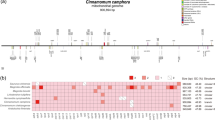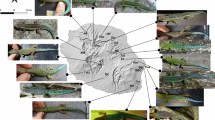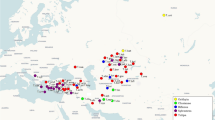Abstract
The endangered species Paeonia rockii is the most important ancestral species of the cultivated tree peonies. These well-known ornamental plants are termed the ‘King of Flowers’ in China. In this study, we investigated the genetic diversity and phylogeographic structure of 335 wild samples from 20 populations throughout the entire distributional range of the species based on three chloroplast DNA sequences (petB–petD, rps16–trnQ and psbA–trnH). At those loci, high levels of genetic differentiation (G ST = 0.94) and low levels of genetic variation (θ = 0.00185) were detected. The intraspecific phylogeny revealed four groups, the western group, the Taibai mountain group, the northern group and the eastern group, which closely coincided with the geographic distribution of the species. A phylogeographic structure of this kind could result from a number of integrated factors, such as allopatric fragmentation, climatic fluctuations, increased abortion and declining germination of seeds, or lack of gene flow among populations, especially across the geographic barrier of the high Qinling Mountains, and it could also result from adaptive evolution. For conservation purposes, each extant population of P. rockii should be recognized as a conservation-significant unit, and a more stringent conservation strategy should incorporate in situ and ex situ methods.


Similar content being viewed by others
References
Arroyo-García R, Lefort F, de Andrès MT, Ibáñez J, Borrego J, Jouve N, Cabello F, Martínez-Zapater JM (2002) Chloroplast microsatellite polymorphism in Vitis species. Genome 45:1142–1149
Cheng FY (2007) Advances in the breeding of tree peonies and a cultivar system for the cultivar group. Int J Breed 1:89–104
Cheng FY, Li JJ, Chen DZ (1997) The natural propagation characteristics of wild tree peony species in China. Acta Hortic Sin 24:180–184
Cheng FY, Li JJ, Chen DZ, Zhang ZS (2005) Chinese flare tree peonies. Chinese Forestry Publishing House, Bei**g
Clement M, Posada D, Crandall KA (2000) TCS: a computer program to estimate gene genealogies. Mol Ecol 9:1657–1659
Comes HP, Kadereit JW (1998) The effect of quaternary climatic changes on plant distribution and evolution. Trends in Plant Sci 3:432–438
Doyle JJ, Doyle JL (1987) A rapid DNA isolation procedure for small quantities of fresh leaf material. Phytochem Bull 19:11–15
Excoffier L, Laval G, Schneider S (2005) Arlequin ver. 3.0: an integrated software package for population genetics data analysis. Evol Bioinform Online 1:47–50
Frankham R (2005) Genetics and extinction. Biol Conserv 126:131–140
Frankham R, Ballou JD, Briscoe DA (2002) Introduction to conservation genetics. Cambridge University Press, Cambridge
Fu LG (1992) Zhong Guo Zhen ** Bin Wei Zhi Wu (The red book of chinese plants—rare and endangered plant species, in Chinese). Sci Press, Bei**g
Ge XJ, Chiang YC, Chou CH, Chiang TY (2002) Nested clade analysis of Dunnia sinensis (Rubiaceae), a monotypic genus from China based on organelle DNA sequences. Conserv Genet 3:351–362
Ge XJ, Hwang CC, Liu ZH, Huang CC, Huang WH, Huang KH, Wang WK, Chiang TY (2011) Conservation genetics and phylogeography of endangered and endemic shrub Tetraena mongolica (Zygophyllaceae) in inner Mongolia, China. BMC Genet 12:1
Grivet D, Heinze B, Vendramin GG, Petit RJ (2001) Genome walking with consensus primers: application to the large single copy region of chloroplast DNA. Mol Ecol Notes 1:345–349
Hewitt G (2000) The genetic legacy of the quaternary ice ages. Nature 405:907–913
Hong DY (1998) Paeonia rockii and its one new subspecies from Mt. Taibai, Shaanxi of China. Acta Phytotax Sin 36(6):538–543
Hong DY (2010) Peonies of the world: taxonomy and phytogeography. Royal Botanic Gardens, Kew
Hong DY, Pan KY (2005) Notes on taxonomy of Paeonia sect. Moutan DC. (Paeoniaceae). Acta Phytotax Sin 43(2):169–177
Hong DY, Pan KY (2007) Paeonia cathayana D.Y. Hong & K.Y. Pan, a new tree peony, with revision of P. suffruticosa ssp. yin**mudan. Acta Phytotax Sin 45(3):285–288
Hudson RR, Slatkin M, Maddison WP (1992) Estimation of levels of gene flow fom DNA sequence data. Genetics 132:583–589
Huelsenbeck JP, Ronquist F, Nielsen R, Bollback JP (2001) Bayesian inference of phylogeny and its impact on evolutionary biology. Science 294:2310–2314
**g XM, Zheng GH (1999) The characteristics in seed germination and dormancy of four wild species of tree peonies and their bearing on endangerment. Acta Phytophysio Sin 25:214–221
Kimura M (1980) A simple method for estimating evolutionary rates of base substitutions through comparative studies of nucleotide sequences. J Mol Evol 16:111–120
Lande R (1988) Genetics and demography in biological conservation. Science 241:1455–1460
Ledig FT, Hodgskiss PD, Jacob-Cervantes V (2002) Genetic diversity, mating system, and conservation of a Mexican subalpine relict, Picea mexicana Martínez. Conserv Genet 3:113–122
Li JJ (1998) Studies on the origin of Chinese Mudan (tree peonies). J Bei**g For University 20(2):22–26
Li JJ (2005) Chinese tree peony (**bei, **nan, Jiangnan Volume). China Forestry Publishing House, Bei**g
Librado P, Rozas J (2009) DnaSP v5: a software for comprehensive analysis of DNA polymorphism data. Bioinformatics 25:1451–1452
Luo YB, Pei YL, Pan KY, Hong DY (1998) A study on pollination biology of Paeonia suffruticosa subsp. spontanea (Paeoniaceae). Acta Phytotax Sin 36:134–144
Meng L, Zheng GS (2004) Phylogenetic relationship analysis among Chinese wild species and cultivars of Paeonia sect. Moutan using RAPD markers. Sci Silvae Sin 40:110–115
Nei M (1987) Molecular evolutionary genetics. Columbia Univ Press, New York
Pei YL, Zou Y, Yin Z, Wang XQ, Zhang ZX, Hong DY (1995) Preliminary report of RAPD analysis in Paeonia suffruticosa subsp. spontanea and Paeonia rockii. Acta Phototax Sin 33:350–356
Petit RJ, Duminil J, Fineschi S, Hampe A, Salvini D, Vendramin GG (2005) Comparative organization of chloroplast, mitochondrial and nuclear diversity in plant populations. Mol Ecol 14:689–701
Pons O, Petit RJ (1996) Measuring and testing genetic differentiation with ordered versus unordered alleles. Genetics 144:1237–1245
Printzen C, Ekman S, Tonsberg T (2003) Phylogeography of Cavernularia hultenii: evidence of slow genetic drift in a widely disjunct lichen. Mol Ecol 12:1473–1486
Rambaut A (1996) Se–Al: sequence alignment editor. Available from http://tree.bio.ed.ac.uk/software/seal
Rannala B, Yang ZH (1996) Probabilty distribution of moulecular evolutionary trees: a new method of phylogenetic inference. J Mol Evol 43:304–311
Sang T, Crawford DJ, Stuessy TF (1997) Chloroplast DNA phylogeny, reticulate evolution, and biogeography of Paeonia (Paeoniaceae). Am J Bot 84:1120–1136
Slatkin M (1993) Isolation by distance in equilibrium and nonequilibrium populations. Evolution 47:264–279
Tamura K, Peterson D, Peterson N, Stecher G, Nei M, Kumar S (2011) MEGA5: molecular evolutionary genetics analysis using maximum likelihood, evolutionary distance, and maximum parsimony methods. Mole Biol Evol (submitted)
Yuan JH, Cheng FY, Zhou SL (2010) Hybrid origin of Paeonia × yananensis revealed by microsatellite markers, chloroplast gene sequences, and morphological characteristics. Int J Plant Sci 171:409–420
Zhang JM, Wang JX, **a T, Zhou SL (2009) DNA barcoding: species delimitation in tree peonies. Sci China Ser C Life Sci 52:568–578
Zou YP, Cai ML, Wang ZP (1999) Systemic studies on Paeonia sect. Moudan DC, based on RAPD analysis. Acta Phytotax Sin 37:220–227
Acknowledgments
We are grateful to three anonymous reviews and Dr. Rehan Naeem for critically reviewing the previous manuscript, providing insightful comments, and great help in English revision. We also deeply thank Mr. Jiajue Li, Dr. Jia Wang, Mrs. Yaling Tian, Mr. Jianhong Wang and the administrative staff of Gansu Forestry system for their help during the sample collection and field work. This study was funded by the Key Project of Science and Technology of State Forestry Administration of China (2006–40).
Author information
Authors and Affiliations
Corresponding author
Rights and permissions
About this article
Cite this article
Yuan, Jh., Cheng, FY. & Zhou, SL. The phylogeographic structure and conservation genetics of the endangered tree peony, Paeonia rockii (Paeoniaceae), inferred from chloroplast gene sequences. Conserv Genet 12, 1539–1549 (2011). https://doi.org/10.1007/s10592-011-0251-8
Received:
Accepted:
Published:
Issue Date:
DOI: https://doi.org/10.1007/s10592-011-0251-8




